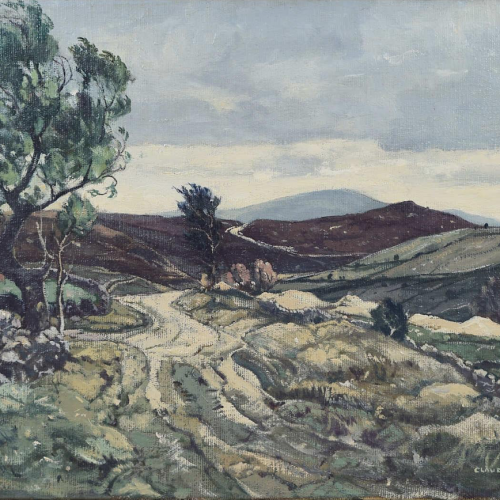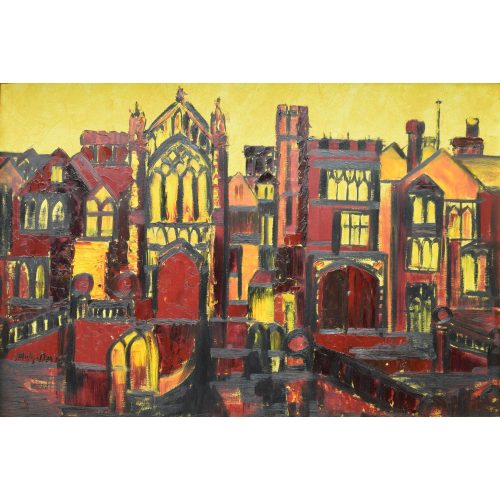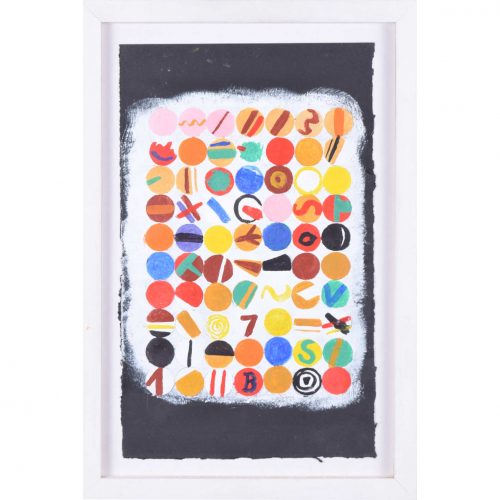-
Out of stock
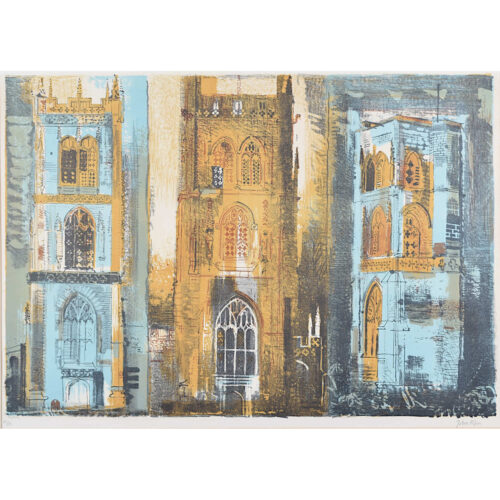
John Piper (1903-1992)
Three Somerset Towers (1973)
Screenprint 56 x 76 cm John Piper CH was an English painter, printmaker, and designer of stained-glass windows. His work often focused on the British landscape, especially churches and monuments, and included tapestry designs, book jackets, screen-prints, photography, fabrics and ceramics. Condition: generally very good; a little age toning. If you are interested, please email info@manningfineart.co.uk or call us on 07929 749056. Click here for other works by John Piper. -
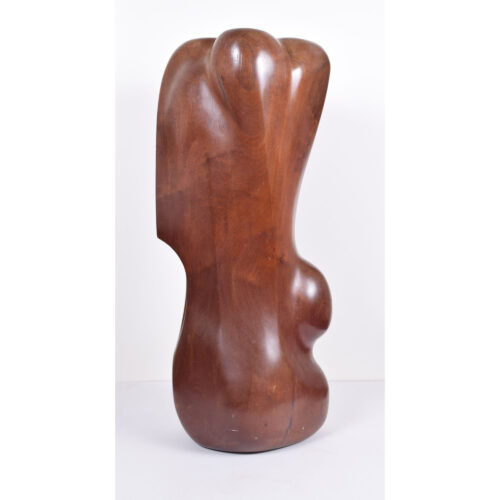
John Robert Murray McCheyne (1911 - 1982)
Metamorphosis (1969)
Polished redwood 96 cm high Provenance: the artist's estate. John Murray McCheyne was a sculptor and teacher. He studied under the sculptor Alexander Carrick at the Edinburgh College of Art between 1930 and 1935. In the 1950s and 1960s he became Master of Sculpture at King’s College, University of Newcastle, and began to work on public sculpture commissions while there. He exhibited at the Palace of Arts' Empire Exhibition Scotland in 1938, and was a regular exhibitor at the Royal Scottish Academy, and the Royal Glasgow Institute. Condition: generally very good; one or two very small scratches. If you are interested, please email info@manningfineart.co.uk or call us on 07929 749056. Click here for other Modern British Sculpture. -
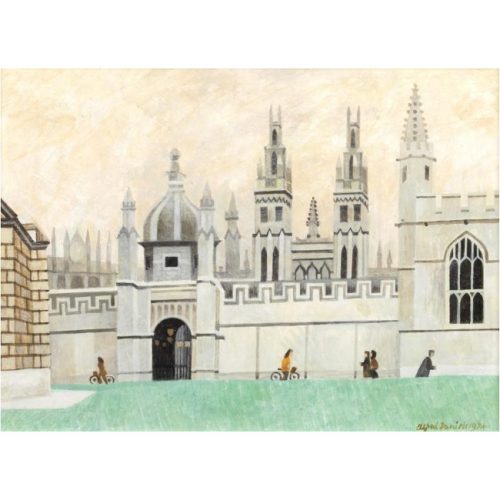 Alfred Daniels RBA RWS (1924-2015) All Souls, Oxford Acrylic on paper In a hand-finished white frame. 22x29.5cm (8.6x11.6 inches) Click here for biographical details and other works by the artist. If you are interested email info@manningfineart.co.uk or call us on 07929 749056.
Alfred Daniels RBA RWS (1924-2015) All Souls, Oxford Acrylic on paper In a hand-finished white frame. 22x29.5cm (8.6x11.6 inches) Click here for biographical details and other works by the artist. If you are interested email info@manningfineart.co.uk or call us on 07929 749056. -
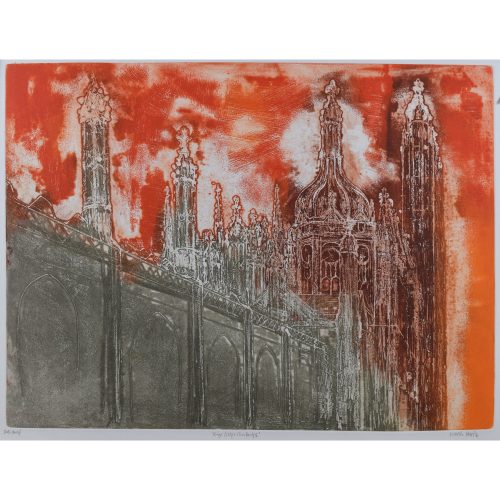
Walter Hoyle (1922 - 2000)
King's College Chapel, Cambridge in red (1965)
Linocut Cambridge Series State Proof, Signed and Titled in pencil. Printed by the artist at Editions Alecto51x69cm Condition: Excellent Click here for biographical details and other works by the artist. If you are interested email info@manningfineart.co.uk or call us on 07929 749056. -

Ethel Louise Rawlins (1880 – 1940)
A Garden Below the South Downs
Oil on canvas51 x 61 cmSigned lower right.Rawlins was a painter who studied at the Slade School of Fine Art and in Newlyn, Cornwall. She settled in Sussex in the early 1920s, and often painted the rolling hills of the Sussex landscape. Here, blue hills and a grey sky serve as the background for an extensive garden complete with stone urns, flowers, and slanting shadows created by the late afternoon sun. -
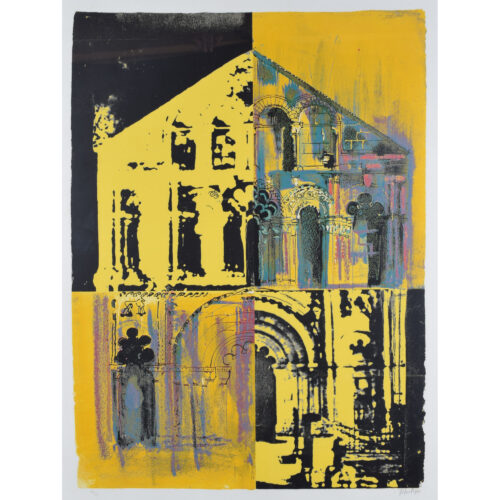
John Piper (1903-1992)
Le Petit Palais (1972)
Screenprint Signed and numbered 18/25 in pencil. Piper's print of the Petit Palais in shades of yellow. The Petit Palais is an art museum in Paris; it was built for the 1900 Exposition Universelle and is now home to the City of Paris Museum of Fine Arts. John Piper CH was an English painter, printmaker, and designer of stained-glass windows. His work often focused on the British landscape, especially churches and monuments, and included tapestry designs, book jackets, screen-prints, photography, fabrics and ceramics. Condition: generally very good; mounted to board. If you are interested, please email info@manningfineart.co.uk or call us on 07929 749056. Click here for other works by John Piper. -
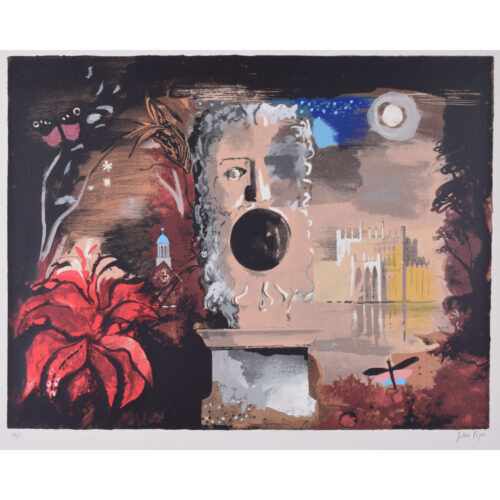
John Piper (1903 - 1992)
Façade (1987)
Lithograph 45 x 60 cm Numbered 96/108 lower left and signed lower right, both in pencil. Printed by Piper and the screenprinter Chris Prater in 1987 after the original designs from 1942. 'Façade' was a sequence of poems written by the English poet Edith Sitwell. They were set to music by William Walton in 1922, four years after they were first written. 'Façade' premiered in 1923 in London, and was praised for its experimental modernist style. The choreographer Frederick Ashton made Façade into a ballet in 1931; Sitwell did not wish her poems to be included, but Walton's orchestral arrangements were used. John Piper was commissioned as set designer for a 1942 performance of Facade in 1942. This lithograph is the design for the performance's curtain; the poetry and music of the performance were played behind the curtain, unseen by the audience. The Gothic house to the right was inspired by Eaton Hall in Cheshire, and we also see a folly, lake, and wood typical of an English country house. The moon, butterfly, and dragonfly lend themselves to the scene's dreamlike aspects, and the mask in the centre of the design highlights the collaborative nature of Façade - a salute to poetry, music, art, and even architecture. John Piper CH was an English painter, printmaker, and designer of stained-glass windows. His work often focused on the British landscape, especially churches and monuments, and included tapestry designs, book jackets, screen-prints, photography, fabrics and ceramics. Condition: very good. If you are interested, please email info@manningfineart.co.uk or call us on 07929 749056. Click here for other works by John Piper. -
Out of stock
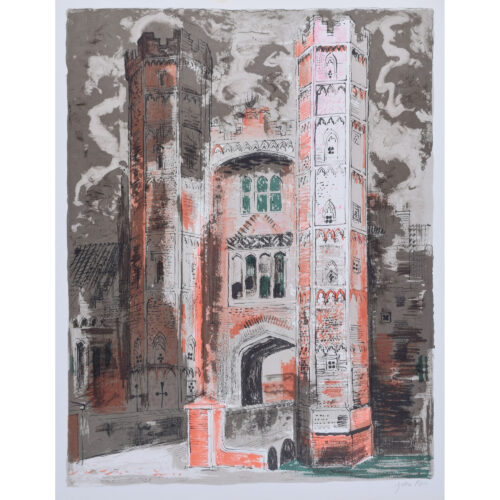
John Piper (1903 - 1992)
Oxburgh Hall (1977)
Lithograph 61 x 48 cm Provenance: Marlborough Galleries. Signed in pencil lower right. Piper's saturnine depiction of Oxburgh Hall, a moated country house in Norfolk now owned by the National Trust. John Piper CH was an English painter, printmaker, and designer of stained-glass windows. His work often focused on the British landscape, especially churches and monuments, and included tapestry designs, book jackets, screen-prints, photography, fabrics and ceramics. Condition: very good; the orange ink is often very faded in the Oxburgh print - this copy remains vibrant. If you are interested, please email info@manningfineart.co.uk or call us on 07929 749056. Click here for other works by John Piper. -
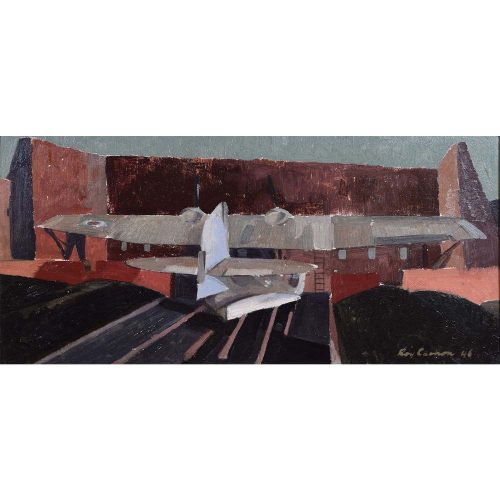
Roy Carnon (1911-2002) Derelict Catalina Redhills Lake near Madras
'Used in Stocks for Gunnery Practice' Oil on board, artist's painted frame Signed and dated 1946 and inscribed with title to reverse Click here for other works by Carnon. This 1946 painting of a derelict Second World War aircraft is a portrait of postwar disillusionment. The battered Catalinas which had survived the war became useful only as ground-based objects for target practice. Carnon's brooding colours and impasto application of paint illustrate how the technologies which helped the Allies to win the war became, overnight, unnecessary. The airmen based in India similarly became unnecessary, but unable to be demobilised they initiated the so-called RAF Mutiny in January 1946. Carnon attended Chiswick Art School becoming an illustrator. In 1965 he was responsible for visualising spacecraft for 2001: A Space Odyssey, being designer of the iconic 'wheel' spacestation. These drawings are now in the Kubrick archives at UAL. If you are interested email info@manningfineart.co.uk or call us on 07929 749056. Condition: Excellent, recently cleaned and in artist's original frame. -
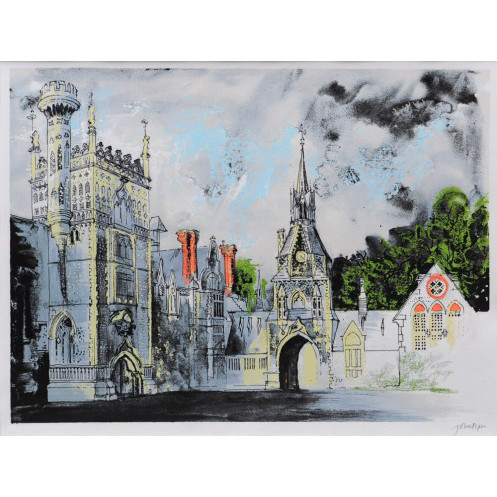
John Piper C.H. (BRITISH, 1903-1992)
Shadwell Park
(Levinson 277) Screenprint in colours, on Arches, signed and numbered. Printed by Kelpra Studio and published by Marlborough Fine Art, London. 510 x 690mm From the 'Victorian Dream Palaces' series of prints by Piper. Click here for biographical details and other works by the artist. If you are interested email info@manningfineart.co.uk or call us on 07929 749056. Condition: generally very good. A little discolouration to extreme margins hidden under mount. In hand-finished black-painted frame. -
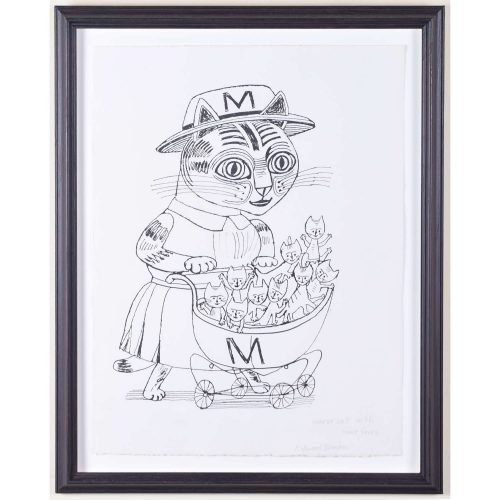
Edward Bawden (1903-1989)
Nurse Cat with Nine Lives
Pen and ink 38 x 27 cm Signed and inscribed lower right. Bawden developed a love of cats at a young age, copying Louis Wain's cat pictures. In his later years, his drawings of cats became yet more frequent; his cat Emma featured in much of his work. In an interview with House and Garden in 1987 he said: "No cat will suffer being lifted up and dropped into an empty space intended for her to occupy; that procedure led inevitably to Emma, tail up, walking away at once, so I had to wait patiently until Emma had enjoyed a good meal of Coley and was ready to choose her daily sleeping place, wherever it might be. I would then spring into action." Doubtless he found it easier to draw an imaginary cat, such as this one. For other cats - and other works - by Bawden, please click here. If you are interested, please email info@manningfineart.co.uk or call us on 07929 749056. -
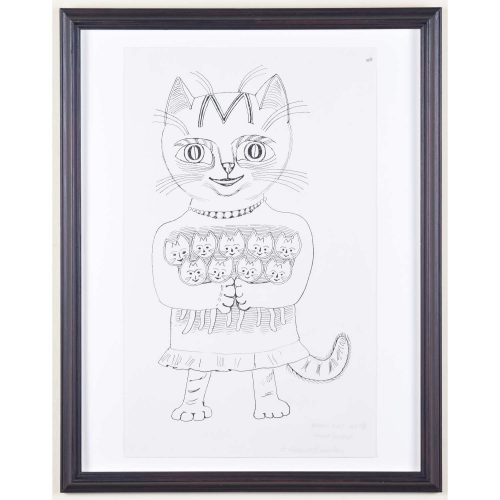
Edward Bawden (1903-1989)
Mum Cat with Nine Lives
Pen and ink 38 x 27 cm Signed and inscribed lower right. Bawden developed a love of cats at a young age, copying Louis Wain's cat pictures. In his later years, his drawings of cats became yet more frequent; his cat Emma featured in much of his work. In an interview with House and Garden in 1987 he said: "No cat will suffer being lifted up and dropped into an empty space intended for her to occupy; that procedure led inevitably to Emma, tail up, walking away at once, so I had to wait patiently until Emma had enjoyed a good meal of Coley and was ready to choose her daily sleeping place, wherever it might be. I would then spring into action." Doubtless he found it easier to draw an imaginary cat, such as this one. For other cats - and other works - by Bawden, please click here. If you are interested, please email info@manningfineart.co.uk or call us on 07929 749056. -
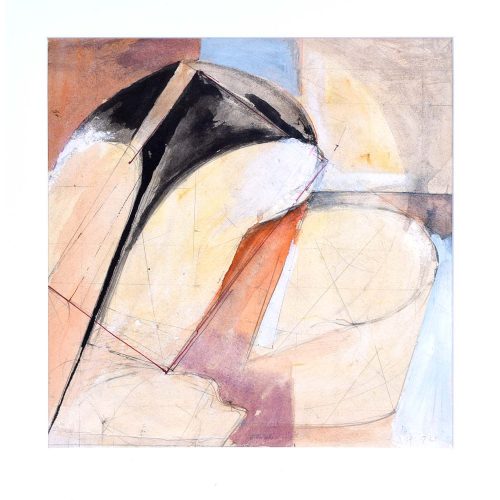
Adrian Heath Abstract Study I (1970)
Gouache & ink 35x33cm Heath was born in Burma in 1920 and arrived in England aged five. In 1938 he studied art under Stanhope Forbes at Newlyn and later at the Slade School of Art. While serving in WWII, he was captured and placed in a prisoner-of-war camp in Bavaria. Heath attempted to escape from the camp but was recaptured and placed in solitary confinement; this isolation proved crucial to the development of his artistic style, as he spent much of his time there experimenting with abstract forms. When released from confinement, Heath befriended a fellow prisoner of war: Terry Frost. Together they explored the methods of painting which they had developed during their time in the camps, and following the war both became celebrated artists. We have several Terry Frost pieces available too. In 1949 and 1951, Heath returned to Cornwall. He spent time with artists like Ben Nicholson, Victor Pasmore, and Anthony Hill, and became the main link between the emerging St Ives School of artists and the British Constructivist movement back in London. He is further credited with promoting British abstract art through informal exhibitions in his studio on Fitzroy Street, as well as his manifesto-like text entitled 'Abstract Art: Its Origins and Meaning', which was published in 1953. Over time, Heath's paintings of abstract geometry and symmetry became increasingly dynamic and heavily textured, the result of layering paint on paint over the course of several days. Here, his colour palette surrenders to the compelling geometry of the painting's abstract forms. If you'd like to know more, please email info@manningfineart.co.uk or call us on 07929 749056. Condition: Good. -

John Piper (1903-1992)
Capesthorne Hall (1977)
Screenprint 64 x 102 cm Piper captures here, in his usual fanciful colours, the Cheshire stately home of Capesthorne Hall. Built in neoclassical style by William Smith and his son Francis, the hall today is used for weddings and other civil occasions. John Piper CH was an English painter, printmaker, and designer of stained-glass windows. His work often focused on the British landscape, especially churches and monuments, and included tapestry designs, book jackets, screen-prints, photography, fabrics and ceramics. Condition: very good; a little old discolouration to edges under mount. If you are interested, please email info@manningfineart.co.uk or call us on 07929 749056. Click here for other works by John Piper. -
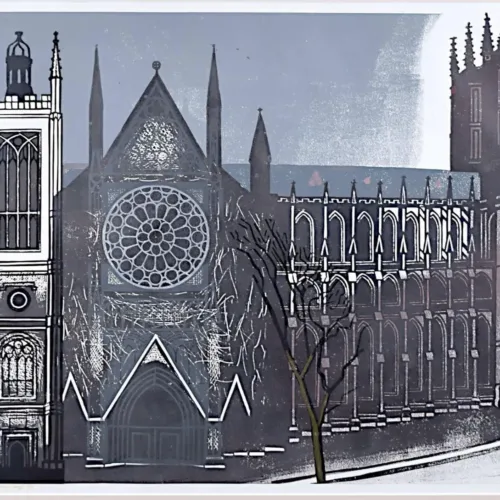
Edward Bawden (1903 - 1989)
Westminster Abbey (1966)
Linocut print 52 x 68 cm (92 x 107 framed) Signed, titled, inscribed 'Artist's Proof' and numbered 42/75 (Bawden inscribed 'Artist's Proof on all of his prints). Bawden's view of Westminster Abbey, cast in shades of blue, grey, and black.Edward Bawden was an English painter, illustrator and graphic artist, known for his prints, book covers, posters, and garden metalwork furniture. Bawden taught at the Royal College of Art, where he had been a student, worked as a commercial artist, and served as a war artist in World War II. He illustrated several books and painted various public murals, and his work and career are often associated with that of his contemporary, Eric Ravilious.Condition: generally very good. Inscription slightly faded. If you are interested, please email info@manningfineart.co.uk or call us on 07929 749056. Click here for other work by the artist. -
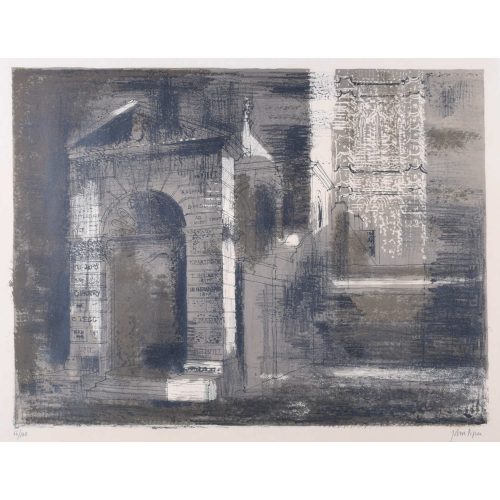
John Piper (1903-1992)
Westminster School I (1961)
49 x 63 cm Signed lower right and numbered 66/100 lower left in pencil. Piper's skilled and characterful rendering of Westminster School's gateway, sometimes known as Burlington's Arch. The historic entrance to the school dates from 1734 and is carved with the names of former pupils. John Piper CH was an English painter, printmaker, and designer of stained-glass windows. His work often focused on the British landscape, especially churches and monuments, and included tapestry designs, book jackets, screen-prints, photography, fabrics and ceramics. Condition: Generally very good, gentle even toning to the paper. If you’d like to know more, please email info@manningfineart.co.uk or call us on 07929 749056. -
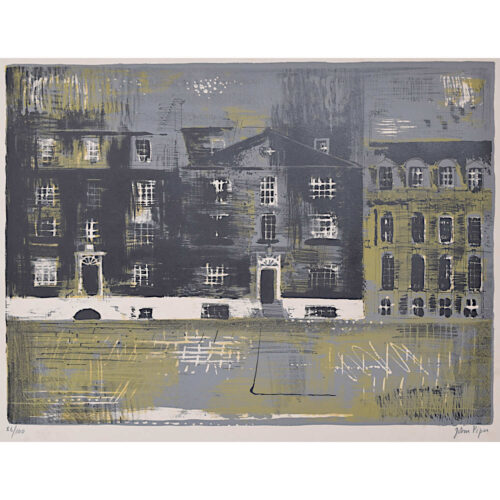
John Piper (1903-1992)
Westminster School II (1961)
42 x 59 cm Signed lower right and numbered 86/100 lower left in pencil. Piper’s second view of Westminster School; both views were commissioned by the school in 1981. Here he depicts Grant's House, with College on the far left and Rigaud’s House on the right. The view is serene and silent, set against a night sky the colour of stone, mimicking the buildings below. John Piper CH was an English painter, printmaker, and designer of stained-glass windows. His work often focused on the British landscape, especially churches and monuments, and included tapestry designs, book jackets, screen-prints, photography, fabrics and ceramics. Condition: generally very good; a little age toning. A few spots to margins. If you’d like to know more, please email info@manningfineart.co.uk or call us on 07929 749056. Click here for other works by John Piper CH. -
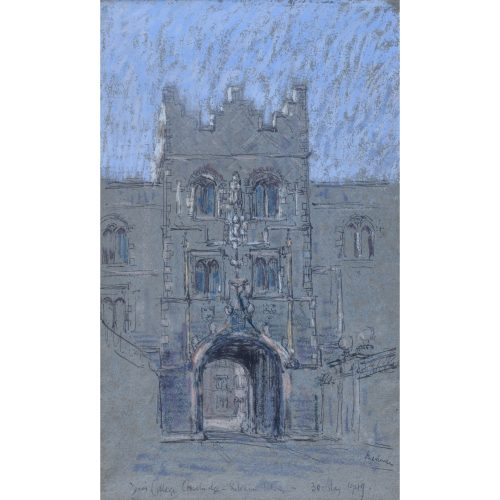
Paul Ayshford Methuen, 4th Baron Methuen of Corsham (1886 -1974)
Jesus College, Cambridge
Ink and pastel Signed and dated 30 May 1949; in artist’s original oak frame. 41x26cm (16.1×10.2 inches) For biographical details and other works by the artist click here. If you are interested email info@manningfineart.co.uk or call us on 07929 749056. -
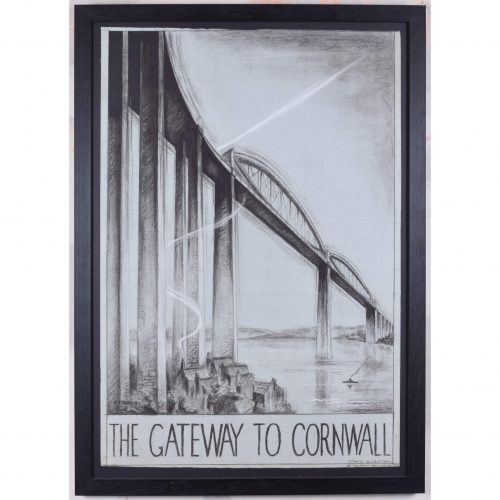
Ronald T Horley (active 1930s - 1940s)
The Gateway to Cornwall
Charcoal heightened with white 76 x 53 cm Signed and inscribed lower right 'Architect's Office, 83 Marlborough Place NW8 Marylebone'. The Great Western Railway commissioned a series of posters promoting train travel around the UK. This charcoal drawing of the Royal Albert Bridge at Saltash is the artist's original design for a poster encouraging rail travel to Devon and Cornwall. The bridge is known fondly as the 'Gateway to Cornwall'. The Royal Albert Bridge was designed by Isambard Kingdom Brunel. Surveying started in 1848 and construction commenced in 1854. The first main span was positioned in 1857 and the completed bridge was opened by Prince Albert on 2 May 1859. Condition: generally very good; a few isolated spots to bottom left corner. Click here for other original vintage travel posters and designs. -
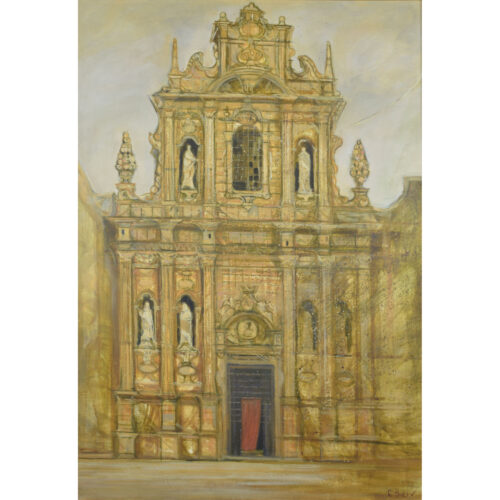
Richard Beer (1928 - 2017)
Lecce Cathedral, Puglia
Oil on canvas 122 x 85 cm Provenance: the artist's studio. A momentous depiction of Lecce Cathedral in all its glory. This oil painting is a fantastic example of Beer's focus on architecture, the central and recurring theme of his pictorial idiom. Born in London in 1928, just too late to serve in the Second World War, Richard Beer studied between 1945 - 1950 at the Slade School. Subsequently, a French Government scholarship allowed him to spend time in Paris at Atelier 17, working under Stanley William Hayter (1901 - 1988), one of the most significant print makers of the 20th Century – having spent the War in New York, advising as a camofleur, Hayter only returned to Paris in 1950. Subsequently Beer studied at the École des Beaux Arts, Paris. Working for John Cranko, choreographer for the Royal Ballet, Beer designed the sets and costumes for his The Lady and the Fool at Covent Garden, subsequently working for him following his move in 1961 to Stuttgart Ballet. Additionally he produced book illustrations and designed book jackets. Beer later taught print-making at the Chelsea School of Art, where he was a popular teacher. Probably his greatest work was a collaboration with John Betjeman to produce a portfolio of prints of ten Wren Churches in the City for Editions Alecto, copies of which are in The Government Art Collection. That collection contains a total of 54 prints by Beer, and the Tate Gallery’s collection holds seven. His Oxford series was also produced for Editions Alecto as was a series of predominantly architectural views in Southern Europe. Most of his prints are of architectural subjects. Condition: generally very good. If you are interested, please email info@manningfineart.co.uk or call us on 07929 749056. Click here for other works by Richard Beer. -

Edward Bawden (1903 - 1989)
Aesop's Fables: Peacock and Magpie (1970)
Linocut print 63 x 75 cm Signed, numbered 11/50, and titled in pencil. A delightful print illustrating Aesop's fable of the Peacock and Magpie. In the fable, the birds are searching for a king, and the Peacock puts himself forward. The birds are about to make him king because of his charming plumage, but a Magpie asks the Peacock how he might defend the birds from predators. The Peacock has no answer. Aesop's moral is that those in power must be suited to the task, and not just vain pretenders. The artist's use of vibrant colour brings the tale to life. Edward Bawden was an English painter, illustrator and graphic artist, known for his prints, book covers, posters, and garden metalwork furniture. Bawden taught at the Royal College of Art, where he had been a student, worked as a commercial artist, and served as a war artist in World War II. He illustrated several books and painted various public murals, and his work and career are often associated with that of his contemporary, Eric Ravilious. Condition: generally very good; small stain to extremity that will be hidden under mount. If you’d like to know more, please email info@manningfineart.co.uk or call us on 07929 749056. -
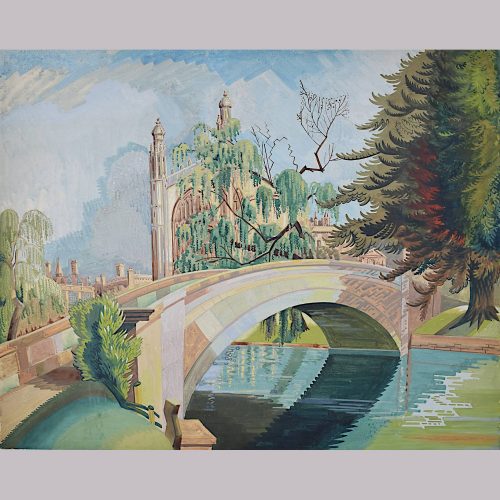
Anonymous King's College Cambridge with the River Cam and Bridge to foreground
51x63.5cm Watercolour Probably 1920s A fine, and large, view of King's College. The artist paints in an art deco style, picking out the stones of the bridge in different colours, the colours all having a heightened sense of reality. Born from cubism, the art deco era is characterised by a fragmented, geometric character particularly evident here. It gives the impression of a shimmering dream. The twenties was an incredible period of change, moving from heavy elaborate styles to a pared back and sleek style expressing more dynamism, an interest in dimension and abstraction. If you are interested email info@manningfineart.co.uk or call us on 07929 749056. -
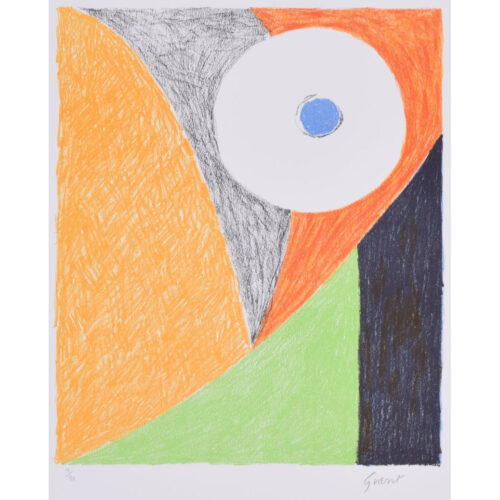
Duncan Grant (1885 - 1978)
Interior (1973)
Lithograph 36 x 30 cm (paper size 77 x 57 cm) Signed 'Grant' and numbered 9/90 in pencil; part of the Penwith Portfolio. Published by Penwith Galleries, St Ives in 1973 with works by Barbara Hepworth, Henry Moore, Peter Lanyon, Alan Davie, Merlyn Evans, John Piper, Ben Nicholson, Robert Adams, Bernard Leach, Michael Rothenstein, and F E McWilliam. An excellent example of Duncan Grant's late work. Duncan Grant was a member of the Bloomsbury Group. He was a painter and also designed textiles, pottery, theatre sets, and costumes. He was a member of the Bloomsbury Group. Condition: generally very good; a few light handling creases in margins. If you are interested, please email info@manningfineart.co.uk or call us on 07929 749056. Click here for more Modern British Art. -
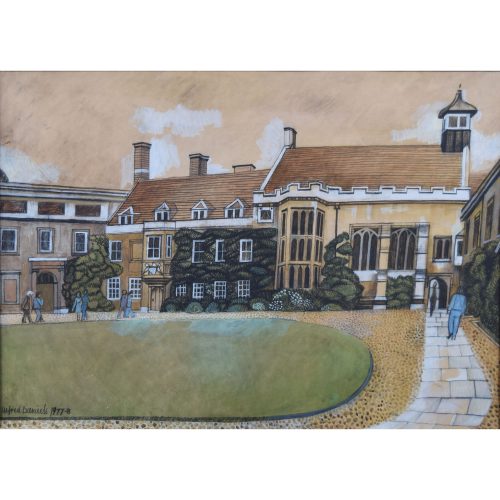
Alfred Daniels RBA RWS (1924-2015)
Christ’s College, Cambridge
Gouache, watercolour and ink on board 40x56cm (15.7×22 inches). In a hand-finished cream frame. Click here for biographical details and other works by the artist. If you are interested email info@manningfineart.co.uk or call us on 07929 749056. -
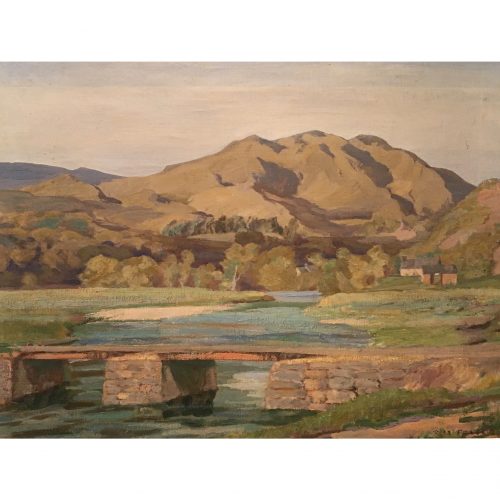
Robert MacDonald Fraser (1870-1947) 'Landscape with Footbridge'
Oil on canvas Signed 20" x 24" (50.5 x 61cm) Though of Scottish descent, an Englishman who was born, lived and died in and around Liverpool. He is believed to have become interested in painting during his secondary school years at the Liverpool Institute and Art School (where the principal was the distinguished landscape artist John Finnie), however his early career was in commerce. By the age of thirty he was well established in Liverpool's art circles but it was to be another decade before he took to painting full time. Between 1910 and 1938 he showed approximately fifty paintings at the Walker Art Gallery in Liverpool, also having seven paintings accepted for the Royal Academy's summer exhibitions. He additionally exhibited at the Manchester Art Gallery, Liverpool Bluecoat and Royal Cambrian Academy, becoming - in 1929 - Vice President of the Liverpool 'Artists' Club.' He mostly painted the landscapes of North Wales and the North West of England. His family owned holiday cottages in North Wales, and Snowdonia provided him with much inspiration, it is believed that this painting is of a Snowdonia scene. If you are interested email info@manningfineart.co.uk or call us on 07929 749056. Condition: Excellent. -
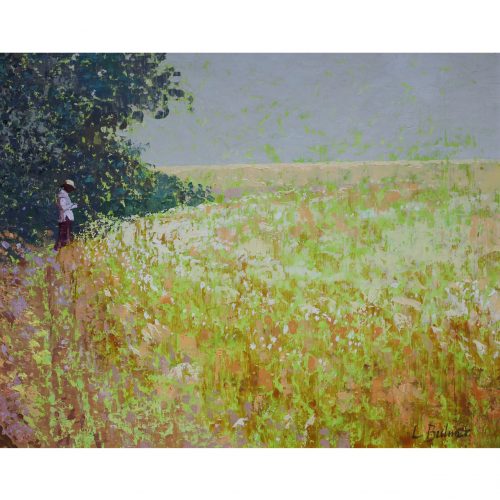
Lionel Bulmer (1919-1992) 'The Edge of the Field' (c. 1950s)
Oil on board 43 x 51 cm Signed lower right. Lionel Bulmer (1919-1992) attended Clapham art school before war intervened; after the war he started again at the Royal College of Art which had been relocated during the conflict to Ambleside in the Lake District. Here he met his lifelong partner Margaret Green who provided the model for many of his works. They returned to London where they studied under painters such as Ruskin Spear and Carel Weight, successors to the Camden Town and Euston Road schools. In the 1950s they moved to West Suffolk and much of Bulmer's work from this point on documents the Suffolk landscape and the coast at Aldeburgh and Walberswick. If you are interested email info@manningfineart.co.uk or call us on 07929 749056. Condition: Excellent. -
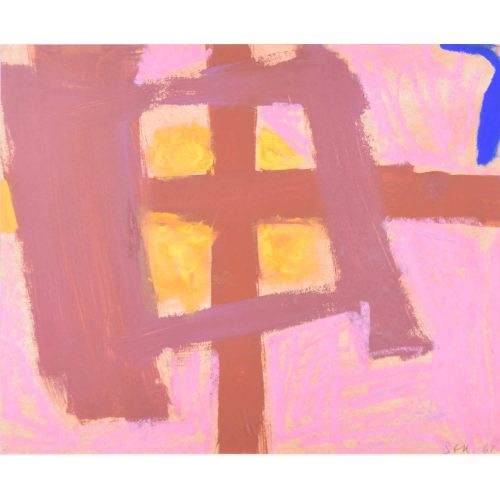
Trevor Bell (1930 - 2017)
Way Out Blue (1961)
Acrylic on paper 35 x 43 cm Signed and dated lower right. Bell's rosy-hued abstract composition is perhaps evoking an interior with window and curtains. The deep azure blue of the picture's title appears at the top right of the composition, curving away from the rest of the image. A sunny golden yellow drips in through the window panes, imbuing the scene with a hot, heady romanticism. Bell's idiosyncratic pictorial language allows us to experience the scene's hazy summer heat via the forms of sun, window, and wall. Bell was born in Leeds in 1930 and attended Leeds College of Art from 1947 to 1952 in a scholarship. The artist Terry Frost encouraged him to move to Cornwall, where he soon became a leading figure in the younger generation of the St Ives school. His first solo exhibition came in 1958, and the year after he was awarded the Paris Biennale International Painting Prize. The Tate began collecting his work in the 1960s, and Bell spent more time working and teaching in America. The Tate's 1985 St Ives exhibition featured Bell's work, and he was also included in the Tate St Ives' inaugural show. He returned from America in 1996 and settled down in isolated barn- and farmhouse-conversion studios near Penzance in Cornwall. He exhibited across England and America for the rest of his life, notably with his major solo exhibition at the Tate St Ives in 2004. Much of his work considers form and landscape via a dramatic use of colour and often on unusually-shaped (and sometimes multi-part) canvases. Condition: very good. If you’d like to know more, please email info@manningfineart.co.uk or call us on 07929 749056. -
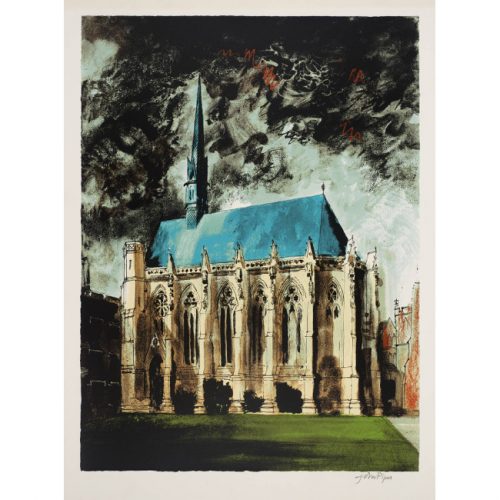
John Piper (1903–1992)
Exeter College, Oxford (1977)
Screenprint Signed in pencil 81.9x61cm (32.2x24 inches) One of Piper's largest and most impressive prints, here featuring Gilbert Scott's chapel at Exeter. It is often claimed that Gilbert Scott based it on Paris's Sainte Chapelle. If you are interested email info@manningfineart.co.uk or call us on 07929 749056. Condition: slight even age toning to paper, small area of repair to print. -
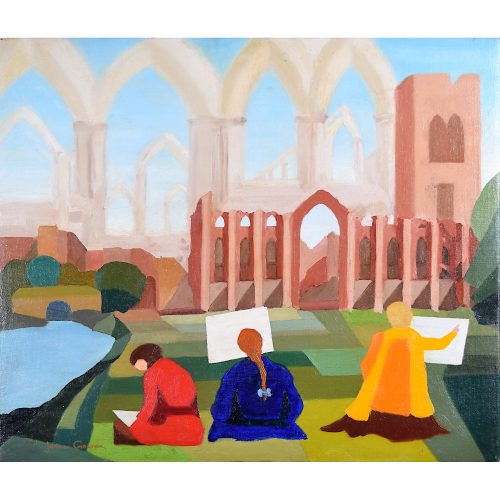
James Gowan (1923, Glasgow - 2015, London) Fountains Abbey (1973)
52x62cm Oil on Canvas Signed 'James Gowan' lower left Inscribed to reverse 'Fountains Abbey 1973 James Gowan No 199' For biographical details and other paintings by Gowan click here. The present work exhibits many of the characteristics obvious in his architectural works. There is a very strong architectural composition. The landscape and sky are approached in almost cubist fashion, reminiscent of the Toblerone-shaped roof of the Leicester Building, whilst the figures have a carefree feel to them. And here indeed are the gothic towers and flying butresses that we know inspired Gowan when designing the Leicester Engineering Building, being captured by the brightly-dressed members of an art class, splashes of primary colour in an already colourful landscape. If you are interested email info@manningfineart.co.uk or call us on 07929 749056. -
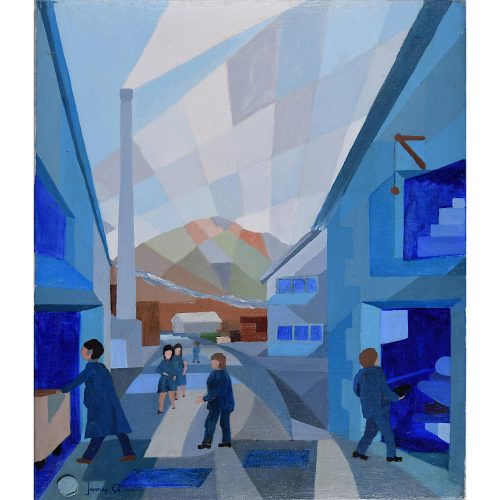
James Gowan (1923, Glasgow - 2015, London) The Blue Mill at Backbarrow
62x52cm Oil on Canvas For biographical details and other paintings by Gowan click here. The present work exhibits many of the characteristics obvious in his architectural works. There is a very strong architectural composition. The landscape and sky are approached in almost cubist fashion, reminiscent of the Toblerone-shaped roof of the Leicester Building, whilst the figures have a carefree feel to them. Backbarrow was the place where the blue pigment ultramarine (or dolly blue - used to return brilliant whiteness to yellowed fabrics) was produced in an old mill building by the Lancashire Ultramarine Company. Dust from the production gave the entire village a blue tint until production ceased in 1981. The factory is now a hotel and it maintains a display of machinery used in the factory. If you are interested email info@manningfineart.co.uk or call us on 07929 749056. -
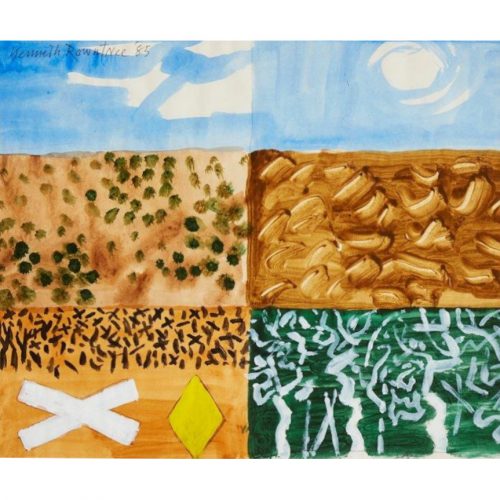
Kenneth Rowntree
Abstract Australian Landscape
Watercolour 27.5 x 33cm Signed (top left) and dated 'Kenneth Rowntree '85' Provenance: Anderson & Garland Studio sale of Kenneth Rowntree lot 263 Tuesday 8 September 2009 For biographical details and other works by Rowntree click here. Rowntree visited Australia in 1984/85. In this painting he picks up various vignettes from the Australian landscape in six separate blocks. Two relate to the sky, with almost-unbroken blue skies stretching from horizon to horizon, three relate to desert areas, with a whole array of different textures, and one is a luscious green. In one of the desert scenes he has picked out two road signs, in typical Rowntree fashion, reducing them to their simplest form. In her essay Kenneth Rowntree: A Strange Simplicity (published in Kenneth Rowntree A Centenary Exhibition Published by Moore-Gwyn Fine Art and Liss Llewellyn Fine Art, on behalf of the artist’s estate, on the occasion of the centenary of Kenneth Rowntree’s birth) Alexandra Harris makes reference to this painting noting:Later, in 1986, just when the young David Hockney was collaging the signs and road-markings of Route 138 in Pearblossom Highway, Rowntree was in Australia painting yellow diamond-shaped road-signs as bright icons in open country. Wherever he went, Rowntree captured both the unfamiliarity of places and their relationship to things he knew. Heading into the Australian outback, he painted a road-sign as he would paint a rail signal at Clare in Suffolk or nautical markers at Swansea.
Hockney's 1986 Pearblossom Highway may be seen here in the Getty and it is worth noting that Rowntree was in fact painting the yellow sign in 1985, so a year before Hockney. If you are interested email info@manningfineart.co.uk or call us on 07929 749056. -
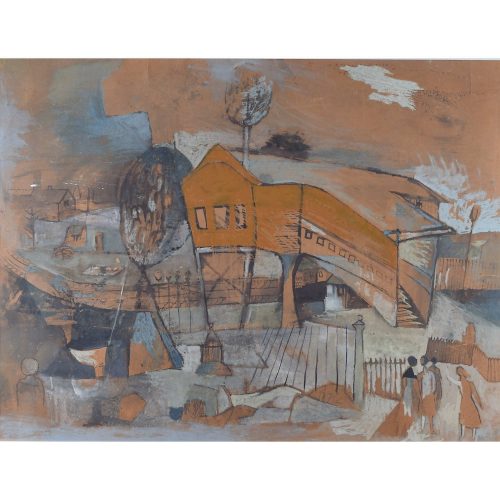
Gwyneth Johnstone (1915 - 2010)
The Railway Bridge
Mixed media 64 x 83 cm Signed lower left in paint, and monogrammed lower left in pencil. Provenance: the estate of the artist. Johnstone explores the possibilities of abstraction in this semi-delirious depiction of a railway bridge. Painted in tones of burnt umber, orange, grey, and black, the picture is populated by warped railings, bending trees, and staring onlookers, all of which centre around a railway line and bridge. Tanya Harrod described Johnstone's painting style a 'a hallucinogenic, haunting pastoral', and that is immensely evident in this picture. Johnstone was an English painter who worked mostly in oils and often depicted poignant modern landscapes. Her parents were the musician Nora Brownsford and the artist Augustus John. She studied at the Slade School of Fine Art, where she established lifelong friendships with fellow artists Mary Fedden and Virginia Parsons. After the Slade, Johnstone was taught academicised cubism by the painter André Lhote at the Académie de la Grande Chaumière in Paris. For a brief period in the early 1950s she took life classes with the surrealist artist Cecil Collins at the Central School of Arts and Crafts. -
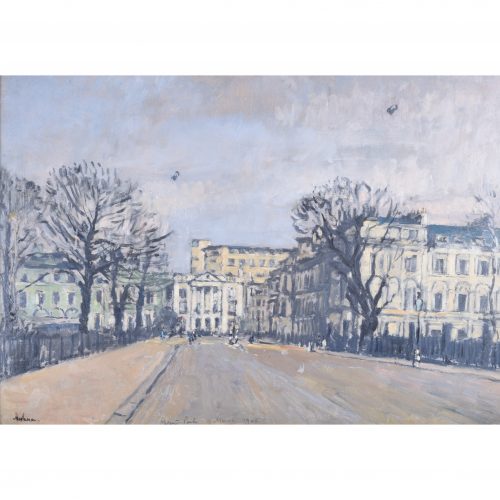
Paul Ayshford Methuen (1886 - 1974)
Barrage Balloons, Regents Park, 9 March 1940
Oil on board 36 x 52 cm Signed lower left and titled and dated lower centre. Lord Methuen's oil painting of Regent's Park on a winter's day, with barrage balloons above. Barrage balloons were set up - stationed at an altitude of around 4,000 ft - as a barrier to enemy aircraft. The steel cables used to tether the balloons would take an enemy aeroplane out of the sky if it were to hit the cable. The UK had thousands of them, filled partly with hydrogen and operated largely by women, to protect significant towns, cities, and military installations. These strange blobs floated over the country, just asking to be captured by artists. Methuen had rejoined his regiment (serving as a Captain) in 1939 but was likely stationed in London for a while, when he might have had the opportunity to capture this scene. When Methuen painted the scene in 1940, Britain was still in the stage of the phoney war. The Battle of Britain did not commence until 10 July, and the Blitz not until 7 September - but Britain's defences were ready. Barrage balloons were important all the way through the War: they defended London against the V2 missiles; they defended the D-Day invasion fleet; and they protected the invasion army for months. Indeed, it was said that the vast amount of material brought into the UK from the States prior to D-Day would have caused Britain to sink under the sea, were it not for the huge number of barrage balloons holding the country up... Condition: excellent. Recently revarnished. If you’d like to know more, please email info@manningfineart.co.uk or call us on 07929 749056. -
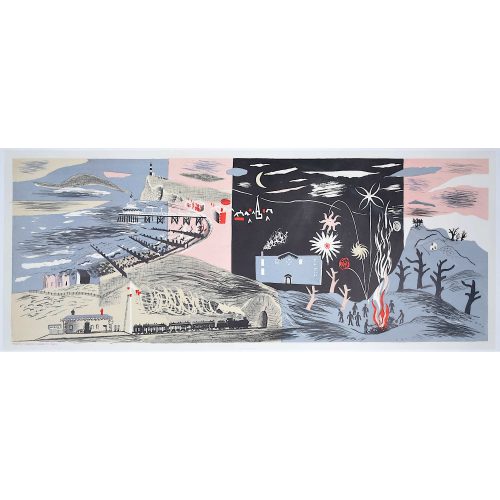
John Piper C.H. (British 1903-1992) Nursery Frieze II
500 x 1250 mm Lithograph 1936 One of Piper's many seascapes, Frieze II is an exercise in abstract capriccio. Piper draws together the muted grey, pink, and blue of the lithograph's fragmented background with foreground details in black, white, and bright red, picking out particular moments of the frieze for the viewer. The lighthouse has no keeper; the beach and the pier are empty; the train has neither passengers nor driver. The church at the top of the rocky hill is a brilliant cubist borrowing, showing both the West end and the North side simultaneously - and it has no congregation. The only human figures present in the frieze are those collected around the bonfire, watching the flames and the show of fireworks. The scene is at once devoid of people and intensely human. Piper was just 24 when he made Frieze II. If you are interested, please email info@manningfineart.co.uk or call us on 07929 749056. Condition: Generally very good, backed to linen with small - and largely not visible - areas of restoration. -
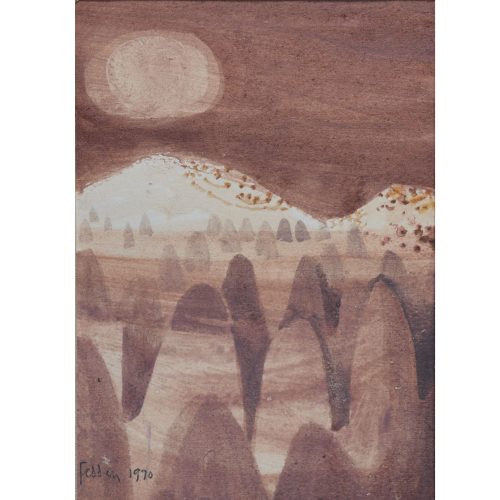
Mary Fedden (1915-2012) Moonlight at Cappadocia (1970)
Watercolour 18 x 13 cm Signed and dated lower left Lonely Planet says of Cappadocia, "As if plucked from a whimsical fairytale and set down upon the stark Anatolian plains, Cappadocia is a geological oddity of honeycombed hills and towering boulders of otherworldly beauty." Here Fedden presents an almost surreal landscape, where the forms of rocks, sky, and moonlight swim out of a subtle palette. If you are interested, please email info@manningfineart.co.uk or call us on 07929 749056. Condition: Excellent. In original frame with replacement mount in the style of the original. -

Brendan Neiland (b.1941)
Original Designs for Intercity Posters - Edinburgh and York
Collage, spraypaint and cut out 91x58cm (36×23 inches) each 1991 Click here for biographical details and other works by the artist. If you are interested email info@manningfineart.co.uk or call us on 07929 749056. -
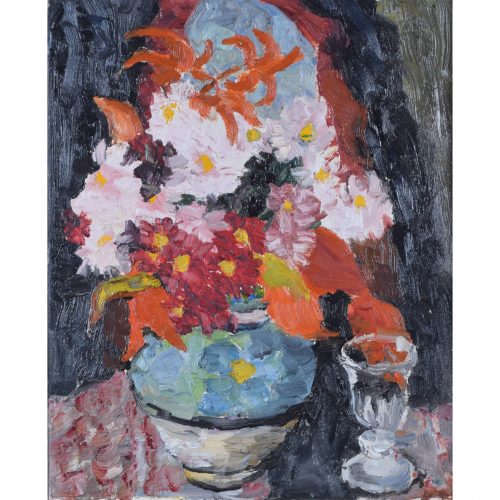
Eva Lucy Harwood (1893 - 1972)
Still Life with Flowers and Glass
Oil on canvas 49 x 40 cm ( 67 x 57 cm framed) A mid-century still life typical of Harwood's impasto style. Lucy Harwood was a British artist who studied art at the Slade just before the outbreak of the First World War. She had initially intended to be a professional pianist, but turned her attentions to visual art after becoming partially paralysed. She was one of the first students to enrol at Cedric Morris' East Anglian School of Drawing and Painting, where she focused on painting Post-Impressionist landscapes, painting just with her left hand. She moved to Upper Layham in Suffolk and is known for her landscapes of the area. Condition: generally very good. Handsome hand-finished frame. Provenance: Louise Kosman, Edinburgh. If you’d like to know more, please email info@manningfineart.co.uk or call us on 07929 749056. Click here to view our other still life pictures. -

John Piper (1903 - 1992)
Radcliffe Camera
Lithograph 53 x 35.5 cm Numbered 110/1150 lower left and signed lower right in pencil. John Piper's view of the Radcliffe Camera in Radcliffe Square. John Piper CH was an English painter, printmaker, and designer of stained-glass windows. His work often focused on the British landscape, especially churches and monuments, and included tapestry designs, book jackets, screen-prints, photography, fabrics and ceramics. Condition: very good. Attractively framed; frame included for mainland UK shipping only. If you are interested, please email info@manningfineart.co.uk or call us on 07929 749056. Click here for other views of Oxford. -
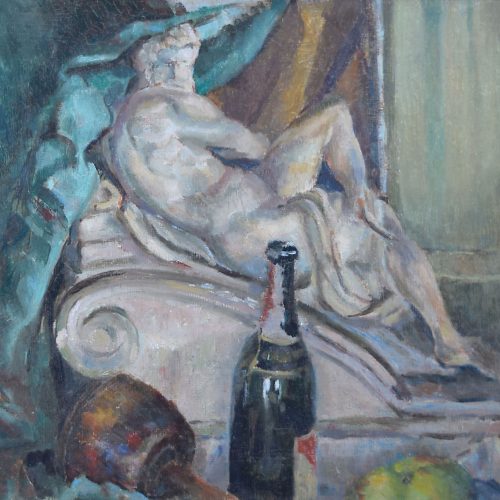 Sir Terry Frost (1915-2003) Bottle and Statue Oil on board c. 1947 38 x 46cm A distinctive still life featuring bottle, statue, and drapery. Terry Frost was a prominent British abstract artist. Frost is most noted for his simplistic abstract forms and unusual colour; he worked alongside the St Ives group and as Barbara Hepworth's assistant for several years, his artistic style being heavily influenced by them. In 1992 he became a Royal Academician, and he was made Sir Terry Frost in 1998. Bottle and Statue highlights Frost's unique compositional skill. His brushwork makes the statue seem like a real nude, who, framed by turquoise and ochre draperies, examines the still life in the foreground. An early work, painted shortly after the War and prior to his adoption of abstraction. For other works by Frost and biographical details please click here. Condition: A little craquelure in the oil above the statue's head.
Sir Terry Frost (1915-2003) Bottle and Statue Oil on board c. 1947 38 x 46cm A distinctive still life featuring bottle, statue, and drapery. Terry Frost was a prominent British abstract artist. Frost is most noted for his simplistic abstract forms and unusual colour; he worked alongside the St Ives group and as Barbara Hepworth's assistant for several years, his artistic style being heavily influenced by them. In 1992 he became a Royal Academician, and he was made Sir Terry Frost in 1998. Bottle and Statue highlights Frost's unique compositional skill. His brushwork makes the statue seem like a real nude, who, framed by turquoise and ochre draperies, examines the still life in the foreground. An early work, painted shortly after the War and prior to his adoption of abstraction. For other works by Frost and biographical details please click here. Condition: A little craquelure in the oil above the statue's head. -

Craigie Aitchison (1926 - 2009)
Yellow Crucifixion
Screenprint 76 x 63 cm Published by Advanced Graphics Limited (2000). Craigie Aitchison’s iteration of the crucifixion sees Christ upon a Cross with no patibulum (horizontal beam). Jesus becomes part of the stipes (vertical beam), a willing participant in his own martyrdom. The star above his head is the Star of Bethlehem, and the sheep or goat at his feet the Lamb of God. These symbols of divinity, set against the backdrop an empty yellow-soaked landscape, transform this picture of the crucifixion into an image of resurrection. Condition: excellent. Magnificently framed. -
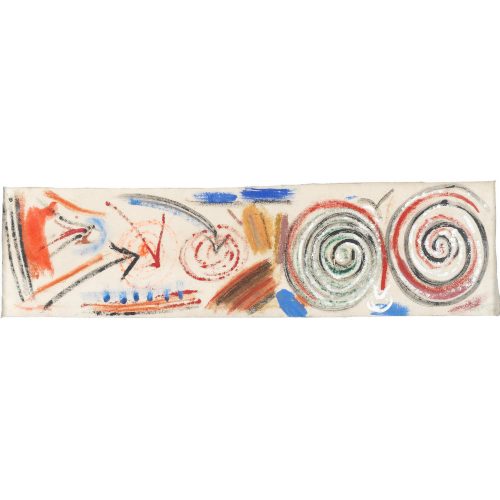
Terry Frost (1915-2003)
'Untitled Landscape'
Oil on canvas, laid on board 22 x 81.5cm Exhibited London, Coram Gallery, Terry Frost: Works on Paper and Small Paintings, 23 September-29 October 1994 Click here for biographical details and other works by the artist. If you are interested email info@manningfineart.co.uk or call us on 07929 749056. -
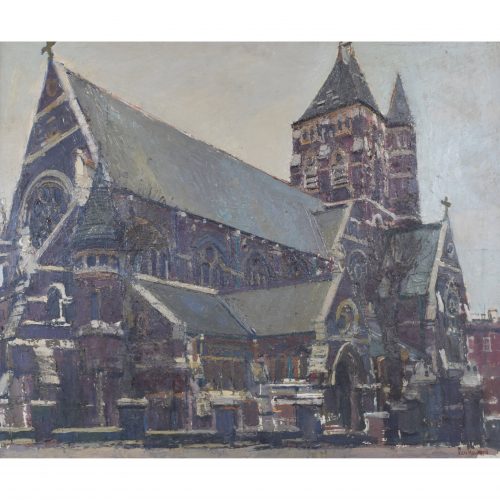
Ken Howard RA (1932 - 2022)
Hampstead Church (St Stephen's Church, Rosslyn Hill)
Oil on board 75 x 91 cm Ken Howard's magnificent view of St Stephen's Church, Hampstead. The artist's rich, deep colour palette and use of impasto underline the neo-gothic style of the church. Howard died in Hampstead and painted several views of the area and its architecture. St Stephen's was designed in the Neo Gothic style by Samuel Sanders Teulon and he considered it the best of the 114 churches he designed, calling it his "mighty church". The building is no longer a church, but wedding ceremonies still take place there; it was made a Grade I listed building in 1974. Kenneth Howard OBE RA was a British artist and painter. He was President of the New English Art Club from 1998 to 2003. He studied at the Hornsey College of Art and the Royal College of Art. In 1958 he won a British Council Scholarship to Florence, and in 1973 and 1978 he was the Official War Artist to Northern Ireland, and 1973 - 80 worked in various locations, including Hong Kong, Cyprus and Canada with the British Army. In 1983 he was elected an Associate of the Royal Academy (ARA). In 1998 he became President of the New English Art Club, a post he held until 2003. In 1991 he was elected a Royal Academician (RA). Howard was given his OBE in 2010. Condition: very good. If you’d like to know more, please email info@manningfineart.co.uk or call us on 07929 749056. -
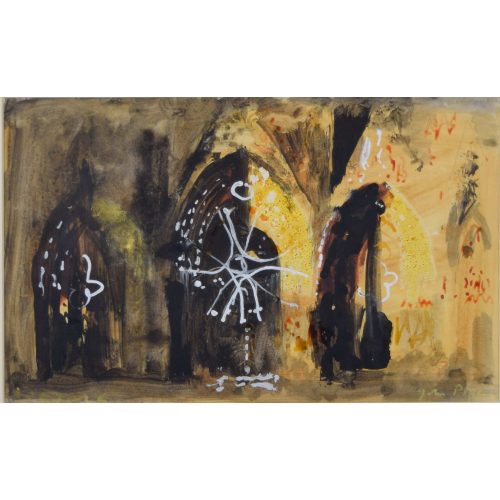
John Piper (1903-1992)
Reims Cathedral (c. 1960)
Ink, watercolour and gouache 21x35cm Inscribed 'Reims' lower left and signed 'John Piper' lower right. Piper loved all things France, and all things Cathedral; in this work, he brings the cathedral of Reims, where France's monarchs were crowned, to life. Piper also produced an aquatint of Reims which was published in 1972. For other works by the artist and biographical details, click here. If you are interested email info@manningfineart.co.uk or call us on 07929 749056. Condition: Generally excellent; framed. -

John Piper (1903-1992)
Bullslaughter Bay
Watercolour, gouache and pastel on paper 27.5 x 35.5cm John Piper CH was an English painter, printmaker, and designer of stained-glass windows. His work often focused on the British landscape, especially churches and monuments, and included tapestry designs, book jackets, screen-prints, photography, fabrics and ceramics. Piper spent a considerable amount of time in Pembrokeshire, frequently returning to the landscape of Bullslaughter Bay; this painting was probably produced there in the mid-1950s. The artist captures an animated, capricious bay, characterised by a distinctive colour palette and stamped with irregular rock formations. Condition: generally excellent. For other works by the artist and biographical details, click here. If you are interested email info@manningfineart.co.uk or call us on 07929 749056. -
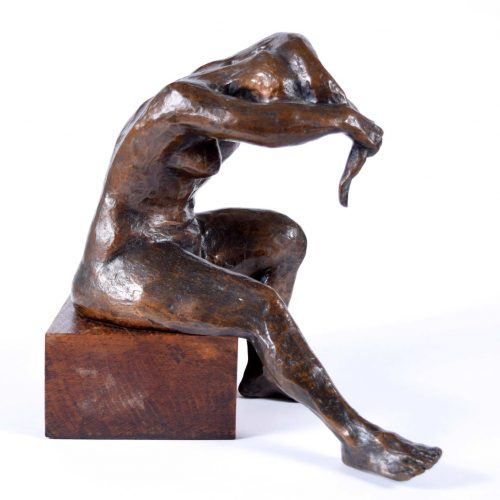 Michael Ayrton (1921-1975) Girl Wringing out her Hair Patinated bronze, 1962 26cm in height Michael Ayrton was a British artist and writer, renowned as a painter, printmaker, sculptor and designer, and also as a critic, broadcaster and novelist. This sculpture, rendered in patinated bronze, is a portrayal of an unposed nude, one of Ayrton's favourite subjects. In his book "Drawings and Sculpture", Ayrton muses on his studies of bathers: 'I like to study the nude when he or she is untroubled by my observation, and bathers in general are the only nudes, or semi-nudes, who are not particularly interested in the onlooker.' Provenance: Acquired directly from the Artist by Nigel Balchin, a close friend of Ayrton's, thence by descent to the previous owner. Sotheby's, Lot 128, 11 July 2013. Literature: Michael Ayrton, Drawings and Sculpture, with a Forward by C. P. Snow, Cory, Adams & Mackay, London, 1962, illustrated pl.73 (another cast). If you'd ike to know more, please email info@manningfineart.co.uk or call us on 07929 749056.
Michael Ayrton (1921-1975) Girl Wringing out her Hair Patinated bronze, 1962 26cm in height Michael Ayrton was a British artist and writer, renowned as a painter, printmaker, sculptor and designer, and also as a critic, broadcaster and novelist. This sculpture, rendered in patinated bronze, is a portrayal of an unposed nude, one of Ayrton's favourite subjects. In his book "Drawings and Sculpture", Ayrton muses on his studies of bathers: 'I like to study the nude when he or she is untroubled by my observation, and bathers in general are the only nudes, or semi-nudes, who are not particularly interested in the onlooker.' Provenance: Acquired directly from the Artist by Nigel Balchin, a close friend of Ayrton's, thence by descent to the previous owner. Sotheby's, Lot 128, 11 July 2013. Literature: Michael Ayrton, Drawings and Sculpture, with a Forward by C. P. Snow, Cory, Adams & Mackay, London, 1962, illustrated pl.73 (another cast). If you'd ike to know more, please email info@manningfineart.co.uk or call us on 07929 749056.

